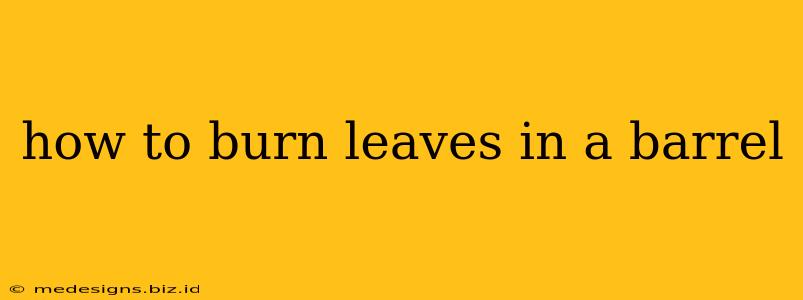Burning leaves in a barrel can be a convenient way to dispose of yard waste, but it's crucial to do it safely and responsibly to avoid environmental hazards and potential legal issues. This guide will walk you through the process, emphasizing safety precautions and best practices.
Before You Begin: Check Local Regulations
This is the most important step. Many municipalities have strict regulations or outright bans on burning leaves. Before you even think about lighting a match, check with your local fire department, city hall, or your homeowner's association. Fines for violating burn bans can be substantial. Knowing your local laws will prevent potential legal trouble and ensure you're acting responsibly.
Preparing for a Safe Leaf Burning Session
1. Choose the Right Location:
- Open Space: Select an area far from buildings, trees, overhanging branches, and anything flammable. A clear space with a minimum of 25 feet of clearance in all directions is ideal.
- Wind Conditions: Avoid windy days. Embers can be carried by the wind, causing fires to spread uncontrollably. Check the weather forecast before you start.
- Water Source: Always have a readily available water source – a hose, bucket of water, or fire extinguisher – nearby.
2. Preparing the Barrel:
- Metal Barrel Only: Use a sturdy metal barrel, preferably one with a lid. Avoid using plastic or other combustible materials.
- Size Matters: A barrel that's too small can create excessive smoke and flames, increasing the risk of fire hazards. A larger barrel provides better airflow and containment.
- Ventilation: Ensure adequate ventilation. A barrel with holes or gaps will allow for better airflow, promoting more complete combustion and reducing smoke. However, these holes shouldn't be too large, as they could allow sparks to escape.
3. Preparing the Leaves:
- Dry Leaves Burn Best: Wet leaves produce excessive smoke and burn inefficiently. Allow leaves to dry before burning.
- Small Piles: Don't cram the barrel. Smaller piles burn more evenly and completely.
The Burning Process:
- Start Small: Begin with a small pile of leaves to establish a consistent burn.
- Controlled Burn: Add leaves gradually, avoiding overcrowding the barrel.
- Monitor Constantly: Never leave the burning barrel unattended. Keep a close eye on the flames and embers.
- Extinguishing the Fire: Once the leaves are completely burned, allow the ashes to cool completely before disposing of them. Pour water slowly and steadily onto the embers to ensure they are fully extinguished. Never leave the barrel until it's completely cool.
Safety First: Essential Precautions
- Never burn leaves near power lines, gas lines, or underground utilities.
- Keep children and pets away from the burning barrel.
- Have a cell phone readily available in case of emergency.
- Inform your neighbors about your leaf-burning plans. This shows respect for their safety and can help prevent misunderstandings.
- Be aware of any air quality advisories. Avoid burning on days with poor air quality.
Alternatives to Burning Leaves
Consider environmentally friendlier alternatives to burning leaves:
- Composting: Composting turns leaves into nutrient-rich soil amendment.
- Mulching: Shredded leaves can be used as mulch in your garden.
- Municipal Collection: Many municipalities offer yard waste collection services.
By following these guidelines, you can safely and responsibly burn leaves in a barrel. Remember, safety and environmental responsibility should always be your top priorities. Always prioritize checking local regulations before proceeding.
